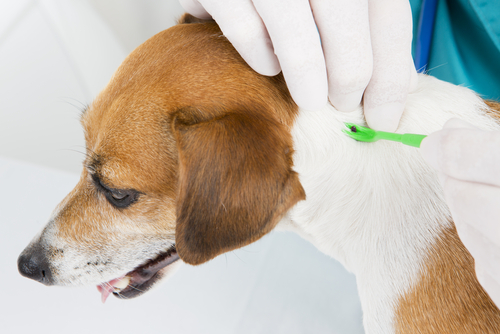
Living and working in the midwestern United States, I’ve seen my share of tick scabs on dogs. When clients in my veterinary practice called me asking what to do after finding a tick or infected tick bite on their pooch, I advised them how to safely remove a tick and what signs to watch for in their dogs. In this article, I’ll provide you with information to help you identify ticks, tick bites or tick scabs on your dog. I’ll explain what you can do about the parasites when you need to take your pup to the vet, and what you can do to protect your dog from ticks.
Ticks on dogs: what do they look like?
Many people mistake ticks for insect pests, but they actually belong to the same family as scorpions and spiders. The adult stage of these pests has eight legs. Various species come in different shapes and sizes depending on whether they are soft (no outer shell) or hard (have a hard outer shield). Soft ticks resemble raisins and are more commonly found on bats or birds.
The parasites you may see on dogs tend to have a hard outer shield that starts just behind the mouthparts. Before they feed on blood, they look like flat seeds.
Below is a picture of several hard ticks on a dog. One of them is engorged with blood.
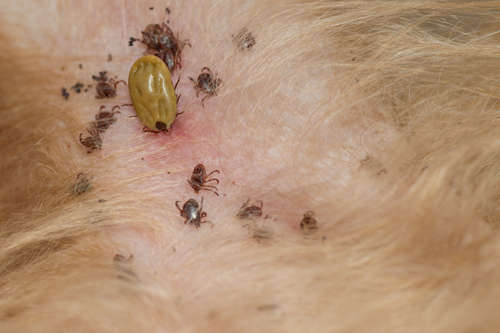
Different tick species carry different diseases: which tick does your dog have?
Depending on where you live, there are seven different types of ticks you may find on your dog. Each species can carry and transmit various diseases.
1. Lone star tick
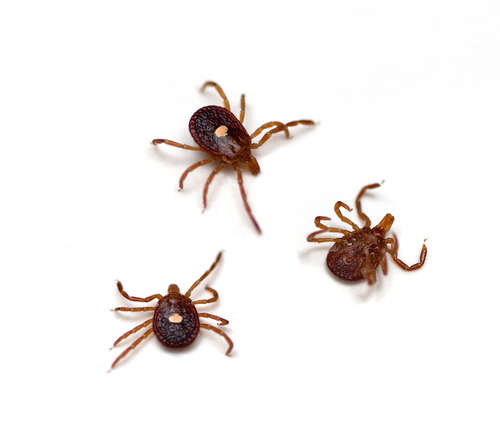
Found in the midwest, eastern, and southeastern United States, lone star ticks usually reside in the underbrush, wooded areas, and along river banks.
- Appearance – They are brown in color, and the females have one white spot on their backs. Males have scattered white flecks.
- Diseases – Ehrlichia, Rickettsiosis, and Tularemia.
2. American dog tick
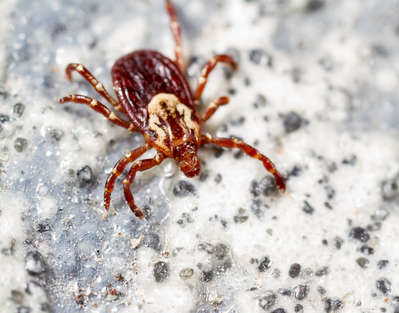
Widely distributed in the eastern, midwestern, and Pacific northwest United States and in Canada, the American dog tick feeds on humans, dogs, and other hosts.
- Appearance – They have a chestnut-brown color and white streaks or spots on their backs.
- Diseases – Ehrlichia, Rocky Mountain spotted fever and Tularemia
3. Brown dog tick
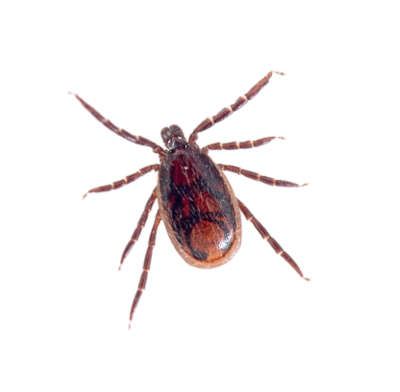
The brown dog tick is found throughout the United States and Canada. This pest rarely feeds on humans, but it can be found in homes and kennels.
- Appearance – This tick has a reddish-brown appearance and likes to feed around the ears or between the toes of dogs.
- Diseases – Anaplasma, Babesia, Bartonella, Ehrlichia, Rocky Mountain spotted fever, and Hepatozoonosis
4. Black-legged tick
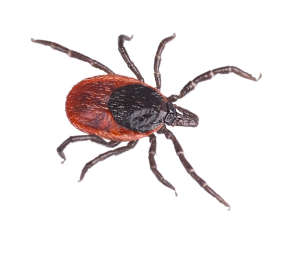
Also known as the deer tick, these parasites usually occur in wooded areas near trails. The Eastern strain is commonly found in the midwestern and eastern United States and Canada while a western strain resides along the Pacific Coast, Arizona, Nevada, and Utah.
- Appearance – Deer ticks have a reddish-brown body with a shield-shaped brown or black area behind the mouthparts.
- Diseases – Anaplasma, Ehrlichia, Lyme disease, and Rickettsiosis
5. Asian long-horned tick
See a picture here. A new arrival to North America, this tick was first found in the eastern United States in 2017. This tick can multiply rapidly because the female is capable of reproducing without mating with a male.
- Appearance – The body is all brown.
- Diseases – It is not currently known if these ticks carry any disease in the US, but they were able to transmit Rocky Mountain spotted fever in the laboratory.
6. Gulf Coast tick
See a picture of a female and male gulf cost ticks here. Found in states along the Gulf of Mexico and Atlantic Coast, this tick is found along coastal uplands and grass prairies.
- Appearance – The female has a dark brown body with a silvery-white plate near the mouthparts. Males are brown with white stripes.
- Diseases – American canine Hepatozoonosis, Tick paralysis, and Rickettsiosis
7. Rocky Mountain wood tick
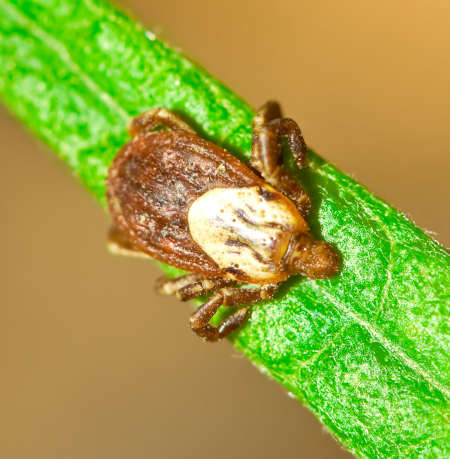
Closely related to the American dog tick, the Rocky Mountain wood tick is found commonly in shrubs, wooded areas, and grasslands of the Rocky Mountain states.
- Appearance – These ticks have bright reddish bodies. Females have a white-colored shield behind the mouthparts, while males have grayish-white spots on their bodies.
- Diseases – Anaplasmosis, Colorado tick fever, Rocky Mountain spotted fever, Tick fever, and Tularemia
Pictures of tick scabs and tick bites on dogs
If a tick attaches to your dog’s skin for a meal and remains undetected, it can leave a wound behind when it detaches. Below are a series of pictures of tick bites on dogs.
1. Normal tick scab
Tick scabs on dogs are usually small and dark blackish-brown in color. They are usually flat, dry, and crusty in appearance:
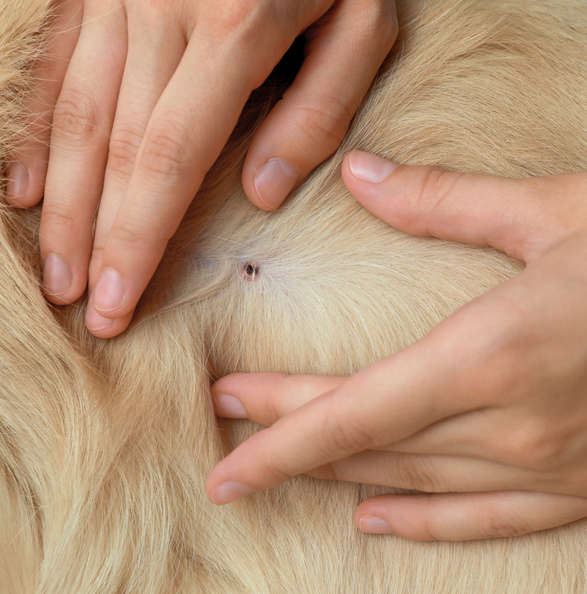
2. Tick scab with head
Below is a picture showing a tick scab with the head remaining in the skin:
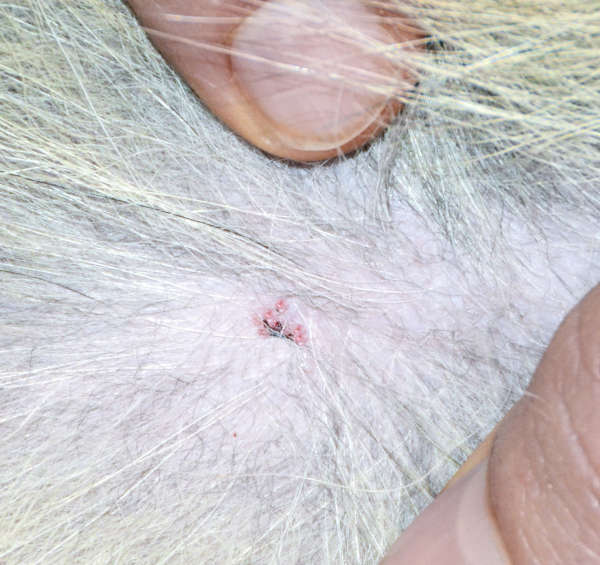
When you find a tick scab or wound with the head remaining, you may notice inflammation and reddening. You may find the head or mouthpiece in the center, and the scab is likely to be raised. Sometimes, you may mistake an embedded tick for a scab.
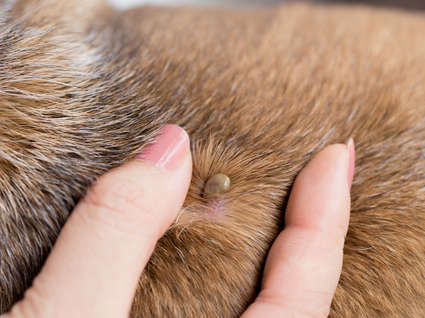
3. Infected tick bite
In this picture, the tick is still embedded in the dog, and the tissue around the bite is red and inflamed:
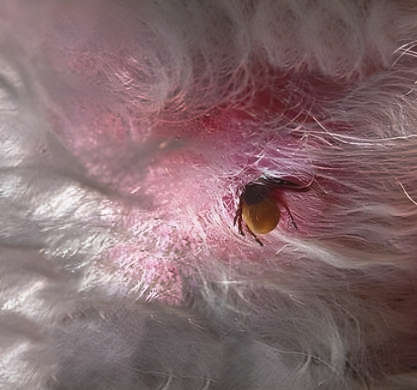
4. Tick bite with bruising
This tick bite is characterized by a dark red bullseye around a black bruise in the center:
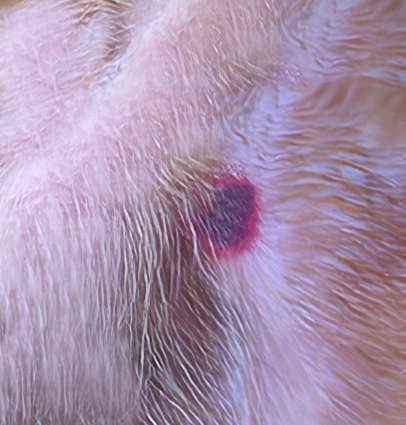
Signs that you need to see a vet about tick scabs or bites
Many times, you may be able to deal with ticks at home(We will discuss how to safely remove a tick from your dog in a later section). However, there are times when you should take your dog to the vet.
- Redness or swelling around the tick bite that persists for more than a day or two
- You fail to remove the whole tick
- Your dog has a heavy infestation of ticks
- You find ticks deep in the ear canal
- Your dog’s health or behavior changes
- You see signs of tick-borne illness(may not appear for 7-21 days or longer)
- Swollen, stiff joints
- Lethargy
- Loss of appetite
- Weakness
- Anemia
- Neurological symptoms
What will the vet do
Your veterinarian may want you to bring one of the ticks you find on your dog with you for identification purposes. After examining your pup and getting a history of the signs you observed and when you first found the ticks, he may take blood tests to diagnose Lyme disease or other tick-borne conditions. In most cases, your pup can be treated with broad-spectrum antibiotics.
Prognosis/Recovery
Early diagnosis and treatment of tick-borne diseases usually result in a favorable prognosis. However, some diseases can recur, so your pup should have periodic screening to detect any reappearance of the disease.
Risks to your dog
Ticks can carry several bacterial and protozoal diseases that are dangerous to dogs. Untreated, these diseases may cause severe illness, organ damage, or death. Additionally, because ticks suck blood, severe infestations can result in anemia in your dog. With all the risks of tick-borne disease, your best course of action is prevention.
How to prevent ticks on dogs
You won’t be able to eradicate ticks from the environment, but there are several things you can do to prevent ticks from feeding on your dog.
- Check your dog for ticks daily or more frequently if he spends most of his time outdoors
- Keep your lawn mown and remove weeds from the yard
- Use over-the-counter tick preventatives such as topical applications or flea and tick collars
- Get a prescription tick preventative from your vet, either
- Topical applications such as Frontline Plus or Bravecto
- Oral medications such as Simparica or Nexgard
What should you do if you see a tick on your dog?
If you find a tick on your dog, you should
- Check him for more ticks – Do a whole-body search including in the ears and between the toes
- Put on gloves – Ticks may contain infectious substances that can pass through your mucous membranes or a cut in your skin
- Expose the tick – Separate your dog’s hair to reveal the embedded tick(s).
- Remove the tick(s) – Using fine-tipped tweezers or a tick removal tool, gently grasp the tick as close to your dog’s skin as possible. Slowly pull the tick directly upward using steady, even pressure. Be careful to extract the complete tick with mouthparts. If any parts are left behind, contact your veterinarian. He should have tools to safely extract the remaining parts and treat the wound.

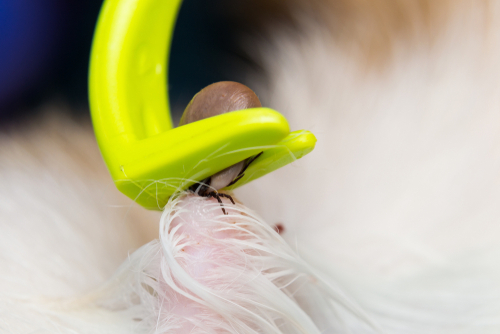
- Clean the wound – Use sterile alcohol to cleanse the wound once the tick is removed.
- Dispose of the tick – Place the tick in an airtight container filled with alcohol.
If you are uncertain about how to remove an embedded tick from your dog, contact your veterinarian. He can demonstrate so that you know what to do next time.
What should you do after the tick is gone?
After you find and remove ticks from your dog
- Clean his bedding and indoor environment to remove any remaining parasites
- Observe him for signs of tick-borne diseases
- Monitor the wound to make sure it doesn’t become infected
- Inform your veterinarian that your dog was bitten by a tick(s) and follow his instructions
- Discuss future prevention with your veterinarian
Disclaimer: This website's content is not a substitute for veterinary care. Always consult with your veterinarian for healthcare decisions. Read More.


My dog got infested with ticks over 50 he has all types of wounds how do I treat
Oh bless him, I’m sorry to hear this.
So, I would certainly want the ticks removed ASAP. The longer they stay on the dog, the more risk of them spreading infections such as Lyme disease.
We want to use a tick remover or tweezers to firmly grasp each tick and then spin it clockwise, until it detaches from the dog. Once this happens, you’ll be able to see its mouth and all of its legs.
We can then put it in an egg cup of alcohol to kill it. We do not want to squish it, as this can spread infection.
Gloves should be worn.
After they’re removed, clean your dog’s skin with some cotton wool and salt water.
I’d use a preventative such as a Seresto collar or Frontline spot on, to prevent them going forward and to ensure these ones are all killed.
Given the amount, I’d also schedule a vet check to ensure all are removed and to check for infection.
“The information on this website is not a substitute for in-person veterinary care. Always seek advice from your veterinarian if you have concerns about your pet’s medical condition.”
My dog has a large red bump on the top of his head located near the left ear. We found three ticks and removed them, however the bump was not found until yesterday. Is this something related to Ticks or Lymes Disease? Should I take him to the Vet?
Hey there, and sorry to hear about this.
Generally, tick borne disease takes a few weeks to develop.
What you’re describing is more likely an inflammatory reaction or abscess, triggered by the tick.
Certainly, a vet check is advised, so they can examine your dog and the lesion.
If it is an abscess, it may need to be drained, and for antibiotics to be issued.
“The information on this website is not a substitute for in-person veterinary care. Always seek advice from your veterinarian if you have concerns about your pet’s medical condition.”
I completely removed a tick bite from between my dog’s toe but she won’t stop licking and favoring the paw. What to do?
Hi there and thanks for reaching out. I am sorry to hear about this. Most of the time, after we remove a tick, there are no ongoing issues. However, it is possible for the area to become irritated and infected. If she is favouring a paw and has a limp, this would indicate she is in discomfort. There would be concern for a joint infection, or perhaps a tick borne disease such as Lyme Disease (depending on the timeline here).
From home, use a buster collar to prevent licking. Bathe the area with salt water or diluted Chlorhexidine.
You should also organise a vet check so the skin can be assessed, and they can determine what the source of pain is and if she may need e.g. some prescribed antibiotics and pain relief.
“The information on this website is not a substitute for in-person veterinary care. Always seek advice from your veterinarian if you have concerns about your pet’s medical condition.”